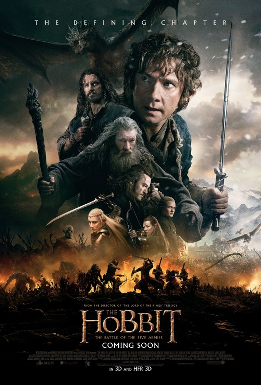Peter Jackson has made a career visually interpreting the works of J.R.R. Tolkien. While his original Lord of the Rings trilogy scored high marks amongst the writer's most faithful, the first two films of The Hobbit weren't quite as big of a success. Much of this has to do with the perception that there isn't enough story to fill three films, a thought that shines brightly as the trilogy comes to a close with The Hobbit: The Battle of the Five Armies.
Telling the final chapter of Tolkien's 1937 classic, The Battle of the Five Armies offers little in the way of plot points. We begin with an action sequence that depicts the defeat of Smaug, moving quicky into another action sequence that involves"¦you guessed it"¦a battle for Smaug's treasure by five ruthless armies.
For the casual viewer who hasn't read the source material (or kept particularly close tabs on the events of the first two films), The Battle of the Five Armies is entertaining. Though there isn't much in the way of story progression, the film does offer some impressive special effects and a long, intense battle sequence that, if nothing else, will keep your eyes from drawing close. And with a runtime just under two and a half hours, it is the shortest film in the trilogy by a hefty margin, another aspect that should please those who are merely seeing the film out of social expectation.
For those that have read Tolkien's epilogue, I can't help but assume that you'll be disappointed. That is, unless you are one of those die hard fans who already love the film even though you haven't seen a second of it yet. Yea, you know who you are.
For what its worth, the battle sequences are well done, and the camera shots capture a brilliant landscape that has been the franchises' backdrop for the last five films. The dialogue is suffering, bringing an audible chuckle to the surface from time to time. But in a film that tries so desperately to showcase a Romeo and Juliet style love affair while a diverse Middle Earth goes after a dragons treasure, I can't say I expected much in the way of poetic interchanges.
For once in the trilogy, the pacing is well captured; though again, there wasn't much material to use for this final reveal. If anything, it was a unique opportunity for director Peter Jackson, who for the first time was forced to translate a single chapter of Tolkien's novel into a two-hour battle of epic proportions. And while he visually mastered his challenge, I can't say the same for the other aspects of the film.
I was intrigued by the number of characters who received ample face time as Ian McKellen, Cate Blanchett and Orlando Bloom saw more of the screen than I had expected. But in a situation like this, star power is always a safe bet.
As the final scene began to take shape and my mind began to process that Bilbo Baggins' journey was nearing its end, I couldn't help feeling a bit perplexed. While I wasn't completely disappointed with the story's final chapter, I also didn't feel overly entertained. Instead, I sat in the middle, annoyed that a third film was even made but content that at the very least, it was a film that non-Tolkien faithful could follow and, to a certain point, enjoy.

